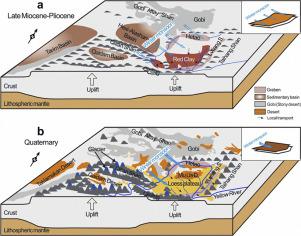当前位置:
X-MOL 学术
›
Palaeogeogr. Palaeoclimatol. Palaeoecol.
›
论文详情
Our official English website, www.x-mol.net, welcomes your feedback! (Note: you will need to create a separate account there.)
Origin of the youngest Cenozoic aeolian deposits in the southeastern Chinese Loess Plateau
Palaeogeography, Palaeoclimatology, Palaeoecology ( IF 3 ) Pub Date : 2021-01-01 , DOI: 10.1016/j.palaeo.2020.110080 Jianguo Xiong , Huiping Zhang , Xudong Zhao , Qingri Liu , Youli Li , Peizhen Zhang
Palaeogeography, Palaeoclimatology, Palaeoecology ( IF 3 ) Pub Date : 2021-01-01 , DOI: 10.1016/j.palaeo.2020.110080 Jianguo Xiong , Huiping Zhang , Xudong Zhao , Qingri Liu , Youli Li , Peizhen Zhang

|
Abstract The origin and provenance of aeolian deposits in China have been controversial for a long time in terms of the spatial and temporal heterogeneity. Recent studies have magnified this complexity. In this study, we conducted the U Pb dating and grain morphological study of detrital zircons from the continuous aeolian deposits in the southeastern Chinese Loess Plateau (CLP). Our results indicate that the upper Pliocene Red Clay in this study is dominantly of local origin and has similar components to the overlying Quaternary loess. The Northeastern Tibetan Plateau (NTP)-Gobi Altay Shan and western North China Craton-North Qinling are the primary and secondary sources of the Quaternary aeolian deposits, respectively. No obvious provenance changes were observed during glacial-interglacial cycles; however, the aeolian deposits became more and more like the deposits in the central CLP with the decrease of sedimentary age. Under the force of tectonic uplift and climate deterioration, the enhanced and topographically constrained winter monsoon has made the NTP-derived materials more dominant since the Quaternary.
更新日期:2021-01-01



























 京公网安备 11010802027423号
京公网安备 11010802027423号